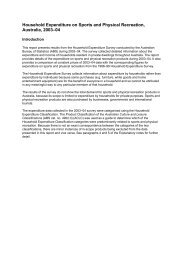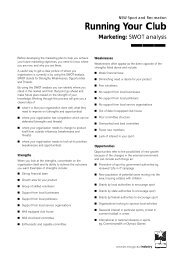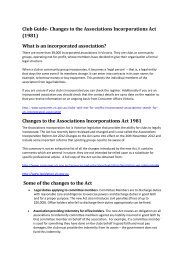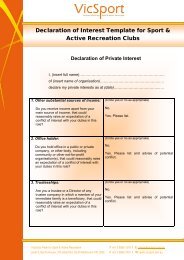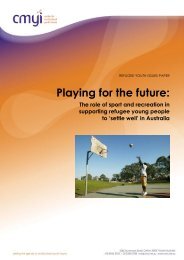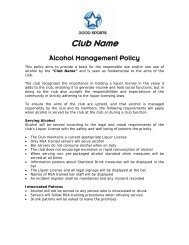School Playing Fields: Planning and Design Guidance - VicSport
School Playing Fields: Planning and Design Guidance - VicSport
School Playing Fields: Planning and Design Guidance - VicSport
You also want an ePaper? Increase the reach of your titles
YUMPU automatically turns print PDFs into web optimized ePapers that Google loves.
Assumption 5: There are 38 lessonsavailable for the whole curriculum,including PE, in a school week.<strong>School</strong>s that have lesson lengths of 40 minutescan fit 40 lessons in a week. We’ve reduced thisfigure by two periods to allow for times whenthere will be no classes scheduled (toaccommodate staff meetings, for example).Assumption 6: 60 minutes of an80 minute ‘double-period’ lessonis spent on a pitch.Although lessons in our worked example last40 minutes, it is assumed that all PE on playingfields will be taught in 80 minute ‘double-period’lessons. To allow time for changing, only 60minutes of such a lesson involves actual usageof the pitch.Assumption 7: There are 20 pupilsin a PE class.This may vary depending on the year group<strong>and</strong> the qualification being studied for. In manyschools, class sizes for those studying forcertificate PE will tend to be lower than thosefor core PE. Whether or not the school considersPE to be a ‘practical’ subject is also important.Practical subjects typically have a maximumclass size of 20, <strong>and</strong> non-practical subjects amaximum of up to 33. Many practitioners takethe view that PE should be considered as apractical subject <strong>and</strong> that consequently themaximum class size for all groups should be20. This approach has been used in our workedexample. This parameter will have a significantimpact on the results of the calculations <strong>and</strong> onassumptions of pitch capacity.Assumption 8: The average groupsize for extra-curricular activity onplaying fields is 25.This is based on discussions with Active <strong>School</strong>sManagers <strong>and</strong> Coordinators.Assumption 9: <strong>School</strong>s use playingfields for 40% of their PE lessonsat certain times of the school year.Previous design guidance for secondary schoolfacilities assumed around 20% of PE activitytook place outdoors. Research for this latestguidance suggests this was a significant underestimate,with schools using their playing fieldsup to 40% of the time <strong>and</strong> in some cases more.The figure of 40% probably represents themaximum use of playing fields in the busiestspring <strong>and</strong> autumn seasons – but as we needto plan for maximum capacity, this is the figureused in the working example.Assumption 10: Synthetic grasspitches are preferred for PE use.Where there is a choice of both grass <strong>and</strong>synthetic pitches at a school, it is assumed thatthe ratio of PE use will be 2:1 in favour of thesynthetic grass pitch.Assumption 11: Extra-curricularuse is split evenly betweensynthetic <strong>and</strong> grass pitches.As extra-curricular use may involve the playingof matches, greater use will be made of thegrass playing fields.Assumption 12: A third of allcurricular group activity needsa full pitch, the other two thirdsneeds only half a pitch.Some PE outdoors will require a full pitch as ateaching space for a class group. Some lessons,such as more intensive skills practice, may needonly half a pitch. And some – for exampleathletics, may need even more than one pitch.To reflect a balanced pattern of use for PE, it isassumed that one third of lessons on both grass<strong>and</strong> all weather pitches will need a full pitch <strong>and</strong>that two thirds will only need half a pitch.Note: This is based on class sizes of 20: if classsizes are larger it is likely that a greater proportionof lessons would require a full pitch.With 60 minutes pitch use for each doubleperiodlesson (Assumption 6), the eight hours ofweekly use of a grass pitch (Assumption 16)gives a total capacity of 12 double-periodlessons per week (comprised of four 60 minutesessions on the whole pitch <strong>and</strong> eight 60 minutesessions using only half the pitch).Assumption 13: Half of all extracurriculargroup activity needs a fullpitch, the other half needs only halfa pitch.Depending on the activity, how it is being played,how it is being taught, what space it needs <strong>and</strong>the age of the participants, the activity may onlyneed half a pitch. This means that two activities,each using half a pitch, can take place at thesame time <strong>and</strong> so increase the capacity of a pitch.Note: In our worked example, if seven of the10.5 hours available to extra-curricular activity(Assumption 14) had one group on a pitch <strong>and</strong>the remaining three <strong>and</strong> a half hours had twogroups (or 2 x 3.5 – equal to seven hours), thiseffectively increases the capacity of a grass pitchto 14 ‘group hours’ for SGPs.As grass pitches cannot sustain such heavy use(Assumption 16), the time available for extracurricularactivity, factoring in the full pitch/halfpitch use, would be a little over 10 hours.Assumption 14: There are 10.5hours a week available for extracurricularactivity on school playingfields.There is a limited amount of time availablefor extra-curricular activity, depending on theresources of a school to stay open outwithnormal school hours <strong>and</strong> the most suitabletimes for pupils to remain at the school. Forthe purposes of this example, we’ve assumed90 minutes after school each day <strong>and</strong> threehours on Saturday mornings, giving a totalof 10.5 hours availability per week.<strong>School</strong> <strong>Playing</strong> <strong>Fields</strong> 16<strong>School</strong> <strong>Playing</strong> <strong>Fields</strong> 17



